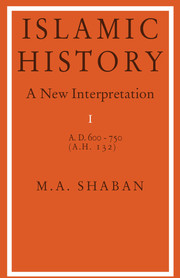Book contents
- Frontmatter
- Contents
- Acknowledgements
- Preface
- 1 The Islamic revolution in its environment
- 2 The emergence of Abū Bakr
- 3 ‘Umar and the conquests
- 4 The breakdown of the Madīnan regime
- 5 Mu‘āwiya and the second civil war
- 6 The age of Ḥajjāj
- 7 Moderate reform, radical reform and reaction: the reigns of Sulaymān, ‘Umar II and Yazīd II
- 8 Hishām: survival of the empire
- 9 The collapse of the Marwānids
- 10 The end of an era
- Works cited
- Index
2 - The emergence of Abū Bakr
Published online by Cambridge University Press: 05 June 2012
- Frontmatter
- Contents
- Acknowledgements
- Preface
- 1 The Islamic revolution in its environment
- 2 The emergence of Abū Bakr
- 3 ‘Umar and the conquests
- 4 The breakdown of the Madīnan regime
- 5 Mu‘āwiya and the second civil war
- 6 The age of Ḥajjāj
- 7 Moderate reform, radical reform and reaction: the reigns of Sulaymān, ‘Umar II and Yazīd II
- 8 Hishām: survival of the empire
- 9 The collapse of the Marwānids
- 10 The end of an era
- Works cited
- Index
Summary
Although Muḥammad died fairly suddenly after a brief illness, he had been visibly in failing health for at least three months. At sixty-three he was an old man, by the standards of the time, and he knew that the end was near. Nevertheless he made no pronouncement on the question of how the umma should continue after him. The famous Shī‘ite tradition that he designated his cousin ‘Alī as his successor at Ghadīr Khum should not be taken seriously. Such an event is inherently improbable considering the Arabs’ traditional reluctance to entrust young and untried men with great responsibility. Furthermore, at no point do our sources show the Madīnan community behaving as if they had heard of this designation. Nor was Muḥammad's appointment of Abū Bakr to lead the prayers during his illness of any importance, for on previous occasions when he was absent he had often delegated this task and indeed the actual affairs of Madina to nonentities. One can only conclude that Muḥammad intended that his followers should settle, on their own, the problem of his succession, if indeed there was to be any successor at all. This fits in very well with his deep understanding of his times and it was the only practical course for him to take.
- Type
- Chapter
- Information
- Islamic HistoryA New Interpretation, pp. 16 - 27Publisher: Cambridge University PressPrint publication year: 1971
- 1
- Cited by



